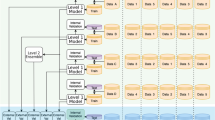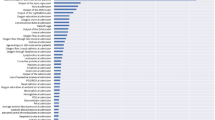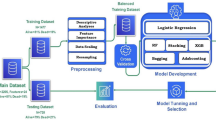Abstract
Ensuring precise and reliable classification effectiveness holds paramount importance in essential sectors such as medicine, industry, and healthcare. Machine learning (ML) techniques have evolved in recent years to address the performance, efficiency, and robustness of the applied models. Recent advancements in Machine Learning (ML) techniques have aimed to enhance the performance, efficiency, and robustness of applied models. Ensemble learning has been shown to exhibit superior accuracy, robustness, and generalization capability over classical single ML models in most classification problems. Although dynamic ensembles have extended the performance of static ensembles such as random forest and boosting, current literature on dynamic ensembles primarily focuses on the early fusion of multimodal data. In this study, we present a novel framework that combines dynamic ensemble selection (DES) with a late fusion of heterogeneous multimodal data and model explainability. We evaluated our approach on a classification task of hospital mortality prediction, and our approach achieves a testing accuracy of 90.16%, surpassing existing techniques and providing physicians with case-based reasoning and deep-based classifiers contributions explanations to support their decision-making. We compare our proposed framework against nine widely used ML techniques, including static and dynamic ensemble models with early fusion and static ensemble models with late fusion on a dataset of 6,600 patients from MIT’s GOSSIS dataset. The dynamic ensemble model with early fusion achieves a testing accuracy of 86.89%, the LightGBM model achieves a test accuracy of 87.72%, and the soft voting model reaches 87.97% and 89.45% using early and late fusion, respectively. Our proposed framework not only improves the accuracy and robustness of in-hospital mortality prediction models but also offers explainability and potential for further optimization to achieve even higher performance.
Access this chapter
Tax calculation will be finalised at checkout
Purchases are for personal use only
Similar content being viewed by others
References
Bonaccorso, G.: Machine Learning Algorithms. Packt Publishing Ltd (2017)
Breiman, L.: Bagging predictors. Mach. Learn. 24, 123–140 (1996)
Cao, Y., Geddes, T.A., Yang, J.Y.H., Yang, P.: Ensemble deep learning in bioinformatics. Nat. Mach. Intell. 2(9), 500–508 (2020)
Chawla, N.V., Bowyer, K.W., Hall, L.O., Kegelmeyer, W.P.: synthetic minority over-sampling technique: smote. J. Artif. Intell. Res. 16, 321–357 (2002)
Cruz, R.M.O., Hafemann, L.G., Sabourin, R., Cavalcanti., G.D.C.: Deslib: a dynamic ensemble selection library in python. J. Mach. Learn. Res. 21(1), 283–287 (2020)
Cruz, R.M.O., Sabourin, R., Cavalcanti, G.D.C.: Recent advances and perspectives: dynamic classifier selection. Inf. Fusion 41, 195–216 (2018)
El-Rashidy, N., Abuhmed, T., Alarabi, L., El-Bakry, H.M., Abdelrazek, S., Ali, F., El-Sappagh, S.: Sepsis prediction in intensive care unit based on genetic feature optimization and stacked deep ensemble learning. Neural Computing and Applications, pp. 1–30 (2022)
El-Rashidy, N., El-Sappagh, S., Abuhmed, T., Abdelrazek, S., El-Bakry, H.M.: An improved patient-specific stacking ensemble model: intensive care unit mortality prediction. IEEE Access 8, 133541–133564 (2020)
El-Sappagh, S., Abuhmed, T., Riazul Islam, S.M., Kwak, K.S.: Multimodal multitask deep learning model for alzheimer’s disease progression detection based on time series data. Neurocomputing, 412, 197–215 (2020)
El-Sappagh, S., Ali, F., Abuhmed, F., Singh, J., Alonso, J.M.: Automatic detection of alzheimer’s disease progression: an efficient information fusion approach with heterogeneous ensemble classifiers. Neurocomputing 512, 203–224 (2022)
Fernández-Delgado, M., Cernadas, E., Barro, S., Amorim, D.: Do we need hundreds of classifiers to solve real world classification problems? J. Mach. Learn. Res. 15(1), 3133–3181 (2014)
Girshick, R., Donahue, J., Darrell, T., Malik, J.: Rich feature hierarchies for accurate object detection and semantic segmentation. In: Proceedings of the IEEE Conference on Computer Vision and Pattern Recognition, pp. 580–587 (2014)
Guyon, I., Weston, J., Barnhill, S., Vapnik, V.: Gene selection for cancer classification using support vector machines. Mach. Learn. 46, 389–422 (2002)
Juraev, F., El-Sappagh, S., Abdukhamidov, E., Ali, F., Abuhmed, T.: Multilayer dynamic ensemble model for intensive care unit mortality prediction of neonate patients. J. Biomed. Inf. 135, 104216 (2022)
Ko, A.H.R., Sabourin, R., Britto Jr, A.S.: From dynamic classifier selection to dynamic ensemble selection. Pattern Recognit. 41(5), 1718–1731 (2008)
Mahesh, B.: Machine learning algorithms-a review. Int. J. Sci. Res. (IJSR).[Internet] 9, 381–386 (2020)
Pedregosa, F., Varoquaux, G., Gramfort, A., Michel, V., Thirion, B., Grisel, O., Blondel, M., Prettenhofer, P., Weiss, R., Dubourg, V., Vanderplas, J., Passos, A., Cournapeau, D., Brucher, M., Perrot, M., Duchesnay, E.: Scikit-learn: machine learning in Python. J. Mach. Learn. Res. 12, 2825–2830 (2011)
Raffa, J.D., Johnson, A.E.W., O’Brien, Z., Pollard, T.J., Mark, R.G., Celi, L.A., Pilcher, D., Badawi, O.: The global open source severity of illness score (gossis). Crit. Care Med. 50(7), 1040–1050 (2022)
Raschka, S.: Mlxtend: providing machine learning and data science utilities and extensions to python’s scientific computing stack. J. Open Source Softw. 3(24) (2018)
Ruta, D., Gabrys, B.: Classifier selection for majority voting. Inf. Fusion 6(1), 63–81 (2005)
Sabourin, M., Mitiche, A., Thomas, D., Nagy, G.: Classifier combination for hand-printed digit recognition. In: Proceedings of 2nd international conference on document analysis and recognition (ICDAR’93), pp. 163–166. IEEE (1993)
Sagi, O., Rokach, L.: Ensemble learning: a survey. Wiley Interdiscip. Rev.: Data Min. Knowl. Disc. 8(4), e1249 (2018)
Sakkis, G., Androutsopoulos, I., Paliouras, G., Karkaletsis, V., Spyropoulos, C.D., Stamatopoulos, P.: Stacking classifiers for anti-spam filtering of e-mail (2001). cs/ arXiv:0106040
Sammut, C., Webb, G.I. (eds.) Holdout Evaluation, pp. 506–507. Springer, US, Boston, MA (2010)
Schapire, R.E.: A brief introduction to boosting. In: Ijcai, vol. 99, pp. 1401–1406. Citeseer (1999)
Stahlschmidt, S.R., Ulfenborg, B., Synnergren, J.: Multimodal deep learning for biomedical data fusion: a review. Briefings Bioinform. 23(2), bbab569 (2022)
Tan, W., Tiwari, P., Pandey, H.M., Moreira, C., Jaiswal, A.M.: Multimodal medical image fusion algorithm in the era of big data. Neural Computing and Applications, pp. 1–21 (2020)
Troyanskaya, O., Cantor, M., Sherlock, G., Brown, P., Hastie, T., Tibshirani, R., Botstein, D., Altman, R.B.: Missing value estimation methods for DNA microarrays. Bioinformatics 17(6), 520–525 (2001)
Acknowledgments
This research was supported by the MSIT (Ministry of Science and ICT), Korea, under the ICT Creative Consilience Program (IITP-2021-2020-0-01821) supervised by the IITP (Institute for Information & communications Technology Planning & Evaluation), and the National Research Foundation of Korea (NRF) grant funded by the Korea government (MSIT) (No. 2021R1A2C1011198).
Author information
Authors and Affiliations
Corresponding author
Editor information
Editors and Affiliations
Rights and permissions
Copyright information
© 2024 The Author(s), under exclusive license to Springer Nature Switzerland AG
About this paper
Cite this paper
Juraev, F., El-Sappagh, S., Abuhmed, T. (2024). Explainable Dynamic Ensemble Framework for Classification Based on the Late Fusion of Heterogeneous Multimodal Data. In: Arai, K. (eds) Intelligent Systems and Applications. IntelliSys 2023. Lecture Notes in Networks and Systems, vol 824. Springer, Cham. https://doi.org/10.1007/978-3-031-47715-7_38
Download citation
DOI: https://doi.org/10.1007/978-3-031-47715-7_38
Published:
Publisher Name: Springer, Cham
Print ISBN: 978-3-031-47714-0
Online ISBN: 978-3-031-47715-7
eBook Packages: Intelligent Technologies and RoboticsIntelligent Technologies and Robotics (R0)




